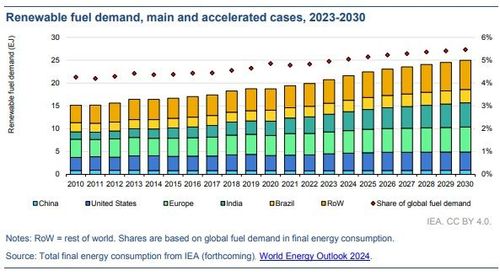IEA predicts 20% growth in renewable fuels by 2030, but says more substantial growth is needed to meet net-zero goals

SOURCE: International Energy Agency
October 10, 2024
BY Erin Voegele
The International Energy Agency on Oct. 9 published its annual Renewables market report, which for the first time includes a chapter focused on renewable fuels that outlines expected growth in liquid biofuels, including sustainable aviation fuel (SAF), biogas, and other forms of bioenergy through 2030.
According to the IEA, the share of renewable fuels in total energy demand is expected to remain below 6% in 2030 despite accelerated growth. In order for growth in renewable fuels to align with the IEA’s scenario for achieving net-zero energy sector emissions by 2050, the report indicates renewable fuel adoption would need to double by 2030. Under current market conditions, however, the sector is only expected to achieve 20% growth.
Advertisement
Advertisement
Bioenergy is expected to account for nearly all growth in the renewables sector through 2030, with bioenergy expanding most significantly in the industrial sector, followed by transportation and buildings. The IEA predicts that road biofuels will remain dominant through 2030, but notes that the consumption of biofuels for aviation and maritime uses is accelerating. The outlook predicts that biofuels for use in aviation will account for approximately 2% of total aviation fuel supply by 2030, from near zero last year. That increase is expected to be supported by mandates in the European Union, United Kingdom and the U.S. In the maritime sector, EU legislation is expected to drive growth, with biofuels accounting for nearly 0.5% of international shipping fuel demand by 2030.
Within the report, the IEA predicts that modern solid bioenergy will account for most renewable fuel growth and use in 2030. The agency explained that solid bioenergy is primarily used for heat, with three-quarters of the increase over the forecast period in the industrial sector. That growth mostly reflects expanding sugar and ethanol production in India, with remaining growth expected to result from the rollout of improved biomass cooking and heating stoves in sub-Saharan Africa, India and China.
Advertisement
Advertisement
Biogas demand is expected to expand by 30% through 2030, led by the U.S. and EU. The use of biomethane in transport is expected to be the main driver of biogas growth in the near term.
The chapter on renewable fuels also addresses expected demand increases for renewable hydrogen and e-fuels for use in transport. By 2030, the IEA predicts that nearly 40% of renewable hydrogen demand is expected to come from the transportation sector, with the remaining 60% used to replace fossil-based hydrogen in refineries, the chemical and fertilizer industries as well as steel production.
A full copy of the report is available on the IEA website.
Related Stories
President Trump on July 4 signed the “One Big Beautiful Bill Act.” The legislation extends and updates the 45Z credit and revives a tax credit benefiting small biodiesel producers but repeals several other bioenergy-related tax incentives.
CARB on June 27 announced amendments to the state’s LCFS regulations will take effect beginning on July 1. The amended regulations were approved by the agency in November 2024, but implementation was delayed due to regulatory clarity issues.
SAF Magazine and the Commercial Aviation Alternative Fuels Initiative announced the preliminary agenda for the North American SAF Conference and Expo, being held Sept. 22-24 at the Minneapolis Convention Center in Minneapolis, Minnesota.
Saipem has been awarded an EPC contract by Enilive for the expansion of the company’s biorefinery in Porto Marghera, near Venice. The project will boost total nameplate capacity and enable the production of SAF.
Global digital shipbuilder Incat Crowther announced on June 11 the company has been commissioned by Los Angeles operator Catalina Express to design a new low-emission, renewable diesel-powered passenger ferry.
Upcoming Events










